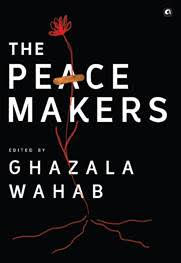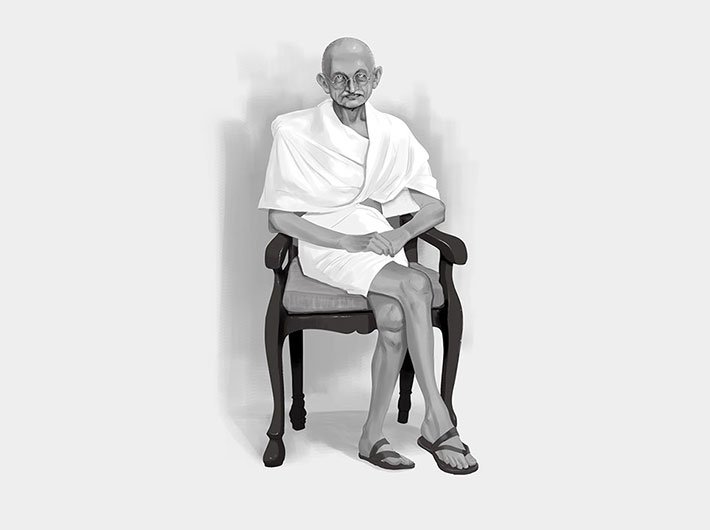An excerpt from an essay by Rajmohan Gandhi, from ‘The Peacemakers’ edited by Ghazala Wahab
The Peacemakers
Edited by Ghazala Wahab
Aleph, 280 pages, Rs 799

India, the land of peace and the birthplace of icons of non-violence such as the Buddha and Mahatma Gandhi, has been riven by violence and conflict throughout its history. Communal riots, caste violence, disputes over sharing of resources, and a variety of other forms of strife continue to blight our nation. Peace, concord, and amity elude us. However, even as horrific incidents of violence continue to plague us, there have always been those who have dared to stand up against the powerful and protect those under attack. This book profiles some of these extraordinary individuals who acted when it counted.
Rajmohan Gandhi chronicles the closing years of Mahatma Gandhi’s life as he worked to stop the violence and bloodshed in Bihar and Bengal soon after Independence (below, read an excerpt from this essay). Human rights lawyer and activist Nandita Haksar writes about the challenges in fostering peace in a conflict zone—Nagaland. Rahul Bedi was witness to the grisly massacre of Sikhs in Delhi following the assassination of Prime Minister Indira Gandhi in 1984; he recalls both the killers and saviours. Journalist Uttam Sengupta tries to resolve the mystery of how Bihar remained peaceful after the demolition of the Babri Masjid in 1992, when other parts of north and west India went up in flames. Jyoti Punwani profiles some members of civil society who risked their lives to ensure peace in the midst of the communal madness in the aftermath of the demolition of the Babri Masjid. Journalist-activist Teesta Setalvad was among the first to record both the violence and efforts at peacekeeping during the Gujarat conflagration of 2002. Her essay shows us that there were those who rose up against violence, at great personal cost. Sunil Kumar, a long-term observer of Maoist violence in the state of Chhattisgarh, profiles the people committed to peace and justice in the restive heart of India. Teresa Rahman’s heart-warming essay chronicles the efforts of a non-government organization working towards the empowerment of women in the once conflict-ridden districts of Assam. Ghazala Wahab recalls the halcyon years of 2005–08 in Kashmir when peace seemed attainable and records the efforts and sacrifices of those committed to a peaceful and just future. Shivam Mogha chronicles the divisive politics and growing insecurity in his hometown of Muzzaffarnagar before it culminated in vicious violence in 2013. He also shines a light on those who rose above the hatred. Natasha Badhwar and Oishika Neogi show that it is possible to do what is right through their essay on the work of Dr Mohammad Anwar during the Delhi violence of 2020. Ramani Atkuri walked part of the way with Rahul Gandhi’s Bharat Jodo Yatra. Her essay introduces us to many people who are invested in an inclusive and just India.
The stories about these peacemakers—activists, journalists, politicians, leaders, and regular citizens—offer us hope that it is possible to rise above the hatred and violence that have characterized India for much of its life as an independent nation.
An excerpt from this book:
Before and after the Partition: Four Years in Gandhi’s Life
By Rajmohan Gandhi
Calcutta
On 9 August 1947, Gandhi arrived in Calcutta on his way to Noakhali, where he wished to spend Independence Day. India would be split in six days, but our peacemaker felt he belonged to both halves. In Calcutta, meanwhile, the Muslim League’s Hasan Suhrawardy, premier of undivided Bengal, was on his way out, and the Congress’s Prafulla Chandra Ghosh was about to take over as chief minister of West Bengal. Many Muslim police officers had been replaced by Hindus.
‘Calcutta’s Muslims are terrified,’ Gandhi was told, and Suhrawardy urged him to spend some days in Kolkata before proceeding to Noakhali and ‘pour a pot of water’ over the city’s ‘raging fire’. He would put off his Noakhali visit, said Gandhi to Suhrawardy, provided ‘you and I are prepared to live together under the same roof.’
He added, ‘I don’t want you to come to a decision immediately. Go back home, and consult your daughter….’
Suhrawardy accepted the offer. Hindu friends who warned Gandhi that Suhrawardy was ‘not to be relied upon’ were told that some Muslims imagined him (Gandhi) ‘to be an enemy of Muslims’.
‘Both of us (Gandhi added) will live under the same roof and have no secrets from each other. We together will see all the visitors. People should have the courage to speak out the truth…in the presence of those against whom it has to be said.’
On 13 August, Gandhi and Suhrawardy moved to Hydari Manzil, ‘an old abandoned Muslim house’ in Beliaghata, a run-down Hindu-majority locality. 14 August was a happy day. The people of Calcutta embraced one another. Hindus were taken to masjids, Muslims to mandirs.
At midnight, India became independent. At 3 a.m., Gandhi opened his eyes in a free India in a Muslim house in one of Calcutta’s humble localities. In the evening, at his request, he was driven quietly through the city. He found that Calcuttans were joyous, excited, and peaceful. Eid day fell on 18 August. 5,00,000 Hindus and Muslims attended Gandhi’s prayer meeting, held on the grounds of the Mohammedan Sporting Football Club.
On the night of 31 August, however, angry Hindus smashed Hydari Manzil’s windows, doors, and ceiling fans. With his aides—Abha Gandhi, Manu Gandhi, and Shiv Balak Bisen— Gandhi came out to meet the demonstrators. Bricks and a lathi were thrown at Gandhi, at an unidentified Muslim who was present, and at Bisen, who the crowd thought was a Muslim.
With Abha and Manu, ‘two very brave girls’, as Gandhi called them, at his side, Gandhi instructed the Muslims in the house and two policemen who were present to remain calm. He asked the crowd to disperse, which they did, though only when a police officer arrived.
Going to sleep at 12.30 a.m., Gandhi was up again in three hours. He wrote to Patel, now India’s home minister, described the incident, and added that he was being asked to visit Punjab, where violence had risen dramatically, crossing the marks left by Bengal and Bihar. Saying that he felt ‘totally lost,’ Gandhi added, referring also to Nehru, ‘I pin my hopes on you two.’
After writing to Patel, Gandhi learnt of other killings in Calcutta. He went to the affected areas and saw ‘two dead bodies of very poor Muslims’. In the afternoon of 1 September, a telegram arrived from Nehru suggesting a visit to Punjab ‘as early as possible’, whereupon Gandhi thought he would do that, giving up Noakhali, even though Patel had written to him, ‘You will not be able to put out the conflagration in Punjab.’
When visitors brought more news of Calcutta’s violence—around fifty had been killed—Gandhi again changed his mind. At about 8 p.m. on 1 September, he decided he would go neither to Noakhali nor to Punjab: he would stay put in Hydari Manzil and fast until peace returned to Kolkata. To Nehru he wrote, ‘If the fury (in Calcutta) does not abate, my going to Punjab will be of no avail.’
Announced at 8.15 p.m. on 1 September, the fast had an immediate impact. That day, young Sachin Mitra had been martyred in Calcutta while leading a peace squad. Two days later, on 3 September, another young Hindu, Smritish Banerjee, lost his life while protecting a peace march.
However, violence died down. Hindus and Muslims marched jointly for peace. Processions of young women and girls of both communities demanded peace. About 500 members of the North Calcutta police force, including a few Britons and Anglo-Indians, went on a twenty-four-hour sympathy fast while remaining on duty. University students gathered weapons from streets and homes and gave them to Gandhi.
Ram Manohar Lohia, who was in Kolkata, brought a band of young Hindus who handed over an arsenal of arms. Members of another gang turned up, asked for ‘any penalty’, and pleaded, ‘Only you should now end your fast.’ Gandhi asked them to go ‘immediately among the Muslims and assure them full protection’.
At 6 p.m. that day, 4 September, a citizens’ deputation of Hindu, Muslim, and Sikh leaders, headed by Suhrawardy, went to Gandhi’s bedside and urged him to end the fast. When Gandhi asked if they would risk their lives to prevent a recurrence, they withdrew to another room, from where they returned with a pledge that they would. Reminding them that ‘above all, there is God, our witness,’ Gandhi agreed to break his fast.
‘Gandhiji has achieved many things,’ Governor Rajagopalachari observed, ‘but in my considered opinion there has been nothing, not even independence, which is so truly wonderful as his victory over evil in Calcutta.’
[The excerpt reproduced with the permission of the publishers.]
